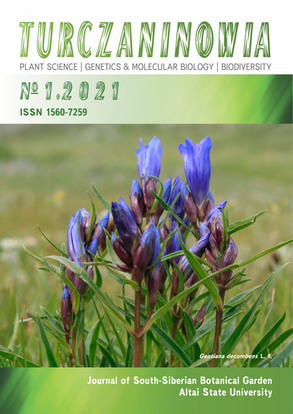Karyotype analysis and chromosome number for two Cirsium taxa (Asteraceae) in Iran
Abstract
Cirsium Mill. contains more than 250 species in the world mainly distributed in the Northern hemisphere. Different chromosome numbers with different ploidy levels were reported in this genus. In this study, karyotype details and chromosome numbers were established for two Cirsium taxa in Iran. C. ciliatum subsp. szovitsii and C. echinus had the mitotic chromosome numbers of 2n = 2x = 34. Karyotype analyses showed that chromosomes were generally metacentric and sub-metacentric. In C. echinus, Lowshan population had the longest chromosome (19.10 µm) and Heyran Canyon population (4.73 µm) the shortest one while in C. ciliatum, the longest chromosome was observed in Urmia to Salmas population (14.67 µm) and the shortest one (4.71 µm) in Doshanlu population. Total haploid chromosome length ranged from 275.29 to 376.42 µm in populations studied. Both taxa were grouped in 2B class. B-chromosomes were recorded for two taxa studied too. Chromosome type, mitotic chromosome numbers and occurrence of B-chromosomes were in agreement with previous results (Albers, Pröbsting, 1998; Lövkvist, Hultgård, 1999; Yüksel et al., 2013; Yildiz et al., 2016).
Downloads
Metrics
References
Albers F., Pröbsting W. 1998. Chromosomenzahlen der Farn- und Blütenpflanzen Deutschlands. In: Standardliste der Farn- und Blütenpflanzen Deutschlands. Eds. R. Wisskirchen, H. Haeupler. Stuttgart: Verlag Eugen Ulmer. Pp. 562–616.
Bureš P., Wang Y. F., Horova L., Suda J. 2004. Genome size variation in Central European species of Cirsium (Compositae) and their natural hybrids. Annals of Botany 94: 353–363. DOI: 10.1093/aob/mch151
Frankton C., Moore R. J. 1961. Cytotaxonomy, phylogeny, and Canadian distribution of Cirsium undulatum and Cirsium flodmanii. Canadian Journal of Botany 39: 21–33.
Frankton C., Moore R. J. 1963. Cytotaxonomy of Cirsium muticum, Cirsium discolor, and Cirsium altissimum. Canadian Journal of Botany 41: 73–84.
Häffner E., Hellwig F. H. 1999. Phylogeny of the tribe Cardueae (Compositae) with emphasis on the subtribe Carduinae: an analysis based on ITS sequence data. Willdenowia 29: 27–39. DOI: 10.3372/wi.29.2902
Hedberg I., Hedberg O. 1977. Chromosome numbers of afroalpine and afromontane angiosperms. Botaniska Notiser 130: 1–24.
Levan A., Fredga K., Sandberg A. A. 1964. Nomenclature for centromeric position on chromosomes. Hereditas 52(2): 201–220. DOI: 10.1111/j.1601-5223.1964.tb01953.x
Lövkvist B., Hultgård U. M. 1999. Chromosome numbers in south Swedish vascular plants. Opera Botanica 137: 1–42.
Melahat O., Hayirlioglu-Ayaz S., Inceer H. 2008. Chromosome counts of some Cirsium (Asteraceae, Cardueae) taxa from Turkey. Caryologia 61(4): 375–382. DOI: 10.1080/00087114.2008.10589649
Nouroozi M., Sheidai M., Attar F., Noormohammadi Z. 2010. Contribution to cytotaxonomy of Iranian Cirsium (Asteraceae). Cytologia 75(1): 119–127. DOI: 10.1508/cytologia.75.119
Nouroozi M., Sheidai M., Attar F., Noormohammadi Z. 2011. B-chromosome and cytomixis in Cirsium (Asteraceae). Cytologia 76(1): 41–47. DOI: 10.1508/cytologia.76.41
Ownbey G. B., Olson W. A. 1969. Cytotaxonomic notes on the species of Cirsium native to the Southeastern United States. Rhodora 71: 285–296.
Ownbey G. B., Raven P. H., Kyhos D. W. 1975. Chromosome numbers in some North American species of the genus Cirsium. III. Western United States, Mexico, and Guatemala. Brittonia 27: 297–304. DOI: 10.2307/2805509
Paszko B. 2006. A critical review and a new proposal of karyotype asymmetry indices. Plant Systematics & Evolution 258: 39–48. DOI: 10.1007/s00606-005-0389-2
Petrak F. 1979. Cirsium. In: Flora Iranica 139a. Ed. K.H. Rechinger. Graz: Akademische Druck-u Verlagsanstalt. Pp. 231–280.
Sheidai M., Seif E., Nouroozi M., Noormohammadi Z. 2012. Cytogenetic and molecular diversity of Cirsium arvense (Asteraceae) populations in Iran. Journal of Japanese Botany 87: 193–205.
Tonian T. R. 1981. New chromosome numbers of species of Cirsium Mill. from Armenia. Biologicheskii Zhurnal Armeni 34: 641–645.
Tonian T. R. 1982. New chromosome numbers of the species of Cirsium in Armenia. Ucenye Zapinski Erevan Universiteta 3: 115–120.
Yildiz B., Arabaci T., Dirmenci T., Köstekci S. 2016. A taxonomic revision of the genus Cirsium Mill. sect. Cirsium (Asteraceae: Cardueae) in Turkey. Turkish Journal of Botany 40: 514–530. DOI: 10.3906/bot-1503-35
Yüksel E., Kiran Y., Şahin A., Yildiz B., Arabaci T. 2013. Karyological studies of 10 Cirsium sect. Epitrachys (Asteraceae) species from Turkey. Turkish Journal of Botany 37: 1085–1092. DOI: 10.3906/bot-1302-1
Zarco C. R. 1986. A new method for estimating karyotype asymmetry. Taxon 35(3): 526–530. DOI: 10.2307/1221906
Zomlefer W. B. 1994. Guide to flowering plant families. Chapel Hill and London: University of North Carolina Press. 430 pp.
Turczaninowia is a golden publisher, as we allow self-archiving, but most importantly we are fully transparent about your rights.
Authors may present and discuss their findings ahead of publication: at biological or scientific conferences, on preprint servers, in public databases, and in blogs, wikis, tweets, and other informal communication channels.
Turczaninowia allows authors to deposit manuscripts (currently under review or those for intended submission to Turczaninowia) in non-commercial, pre-print servers such as ArXiv.
Authors who publish with this journal agree to the following terms:
- Authors retain copyright and grant the journal right of first publication with the work simultaneously licensed under a Creative Commons Attribution License that allows others to share the work with an acknowledgement of the work's authorship and initial publication in this journal.
- Authors are able to enter into separate, additional contractual arrangements for the non-exclusive distribution of the journal's published version of the work (e.g., post it to an institutional repository or publish it in a book), with an acknowledgement of its initial publication in this journal.
- Authors are permitted and encouraged to post their work online (e.g., in institutional repositories or on their website) prior to and during the submission process, as it can lead to productive exchanges, as well as earlier and greater citation of published work (See The Effect of Open Access).









